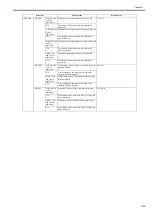
Chapter 7
7-28
7.1.4 e-Maintenance/imageWARE Remote
0023-1100
1. Overview
The e-Maintenance/imageWARE Remote system allows a customer's device information and status to be monitored via the Internet on a server called the UGW
(Universal Gateway) Server.
The following device information/ statuses can be monitored.
- Service mode counters
- Parts counters
- Mode counters
- Firmware information
- Service call errors log
- Jam log
- Alarm log
- Alert change statuses (Toner/ ink low/ out, etc.)
Device monitor information above is sent by the e-RDS (embedded Remote Diagnostic System), which is embedded in the devices.
Further, as the above is all customer information, https SOAP protocol is used for communication between the UGW and the device, providing enhanced security
(SSL client communication)
F-7-32
2. Feature and benefits
Device (e-RDS) embedded with network module can realize a front-end processing of the e-Maintenance/imageWARE Remote system without attaching an extra
hardware equipment.
The e-Maintenance/imageWARE Remote system can be implemented without imposing a burden on the users.
3. Settings procedures
3.1 Advance preparations
To monitor the device with e-Maintenance/imageWARE Remote, the following settings are required.
1) Advance confirmation
Check with the UGW administrator whether the printer to be connected to the e-Maintenance/imageWARE remotely has been registered in the UGW.
2) Advance preparations
Interview the user's system administrator in advance to find out the following information about the network.
Information item -1
IP address setting methods
Check whether automatic setting or manual setting is to be used, and confirm the information below.
- Automatic setting: (DHCP, RARP, BOOTP) (ON/OFF selection)
or
- Manual setting: IP address, subnet mask and gateway address to be set
Information item -2
Is there a DNS server in use?
If there is a DNS server in use, find out the following.
- Primary DNS server address
- Secondary DNS server address (optional)
Information item -3
Is there a proxy server?
If there is a proxy server in use, find out the following.
- Proxy server address
- Port number connected to proxy server
Information item -4
Is proxy server authentication required?
If proxy server authentication is required, find out the following.
- User name and password required for proxy authentication
3) Network settings
Make the network settings based on the information obtained in "2) Advance preparations."
Network settings are made in user mode. Therefore, it is assumed that the user has already set it. However, there are a few cautions as described below, and if
necessary, there may be cases in which the service technicians do it after obtaining an approval from user.
Caution point -1
Proxy server settings
Proxy server settings cannot be made in "Remote UI". Enter from the operation panel menu. In addition, the operation panel menu items for proxy server only appear
when e-RDS functions are enabled. Therefore, when you make proxy server settings, turn the "E-RDS SWITCH" setting to "ON" as described in later sections
beforehand.
Caution point -2
Validate the settings (restart the printer)
UGW
e-RDS
Summary of Contents for image Prograf iPF780 Series
Page 1: ...Mar 27 2014 Service Manual iPF780 760 750 series iPF785...
Page 9: ...Chapter 1 PRODUCT DESCRIPTION...
Page 57: ...Chapter 2 TECHNICAL REFERENCE...
Page 117: ...Chapter 3 INSTALLATION...
Page 125: ...Chapter 4 DISASSEMBLY REASSEMBLY...
Page 175: ...Chapter 4 4 49 2 Shaft Cleaner 1 F 4 97 1 1...
Page 176: ...Chapter 4 4 50 3 Upper Cover Hinge Catch 1 Roll Cover Slide Guide 2 F 4 98 2 1...
Page 179: ...Chapter 5 MAINTENANCE...
Page 186: ...Chapter 6 TROUBLESHOOTING...
Page 212: ...Chapter 7 SERVICE MODE...
Page 267: ...Mar 19 2014 PARTS CATALOG iPF786 785 781 780 765 760 755 750...
Page 301: ...2 25 FIGURE 10 PLATEN GUIDE UNIT 1 3 6 2 8 4 5 10 10 10 9 9 11...
Page 326: ......


































